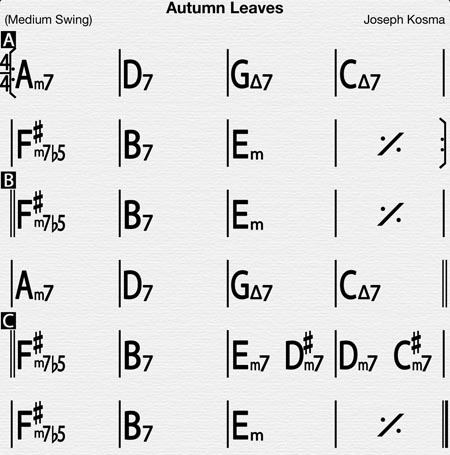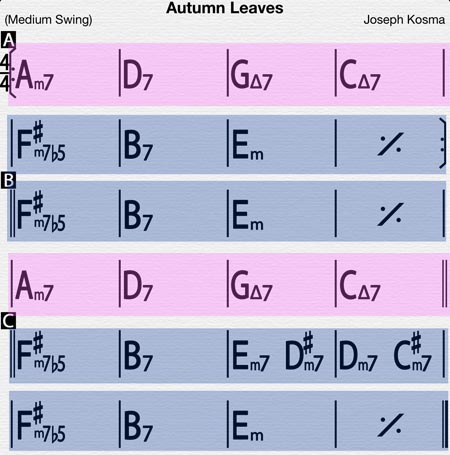« Best of JM: Making sense. More than five senses? |
Main
| Best of JM: Raking it in. Autumn Leaves Pt. 2 »
 July 24, 2014 | Best of JM: Raking it in. Autumn Leaves Pt. 1 July 24, 2014 | Best of JM: Raking it in. Autumn Leaves Pt. 1
Enjoy the popular archive material below.
From July 5, 2012 | Raking it in. Autumn Leaves Pt. 1.
We love music theory. It's a great tool for looking under the hood and exploiting beneficial shortcuts to creating and understanding music. We use it in even in our "mechanical" approach to the fretboard, our movable FFcP system. You've probably noticed we've inserted intervals (3rds, 4ths), some arpeggiated chords, and some passing/approach tone drills in the system. It's finger coordination but if you've been listening while you play, there's some heavy subconscious aural training going on, too.
Still, theory is no good if you don't apply it. We want to go out of the lab now and into the field with the jazz standard, Autumn Leaves and show you a simple way to apply two FFcP patterns to this classic.

Without altering with any sophisticated substitutions, you can trim this down to just two patterns based on two keys. The whole song is in only two keys, E minor, and it's relative G major. We'll draw from two finger patterns to come up with the one-octave field of notes to harvest. The idea is you can go back to the Dorian/Minor FFcP drills, pick up the 4th FFcP in D minor and move it up a couple frets to E minor. Your 4th finger starts the pattern on the 9th fret.

Before you start playing the tune, drill the 4th FFcP in this key for awhile. Take a few days even, until you are comfortable with it.

The next thing would be to take a 2nd FFcP incarnation of the G scale by basing the one octave field with the second finger on the 5th fret. Note, you aren't moving hardly at all from the E minor. Work it similarly until it becomes second nature, reviewing what we created for Bb in the FFcP Introduction series.
When you feel solid on this you're ready to start applying the new found scale intuitive proficiencies to the actual song. Below is a color coded interpretation of where you would use the FFcP patterns, the pink shows where you'd use G major, the blue would be E minor (dorian).

We don't want to go too deep in the semantics of raised 6th and 7th in the minor scale, other than to say when you're using the Dominant Function chord B7, you'll probably be rasing the D to a D#. This is where the chord/arpeggio part of the drill can help out. Trust your ear--it will tell you what to do.
This is where the rubber meets the road, theory to real life. We're still at a point where if this is all you do, grab scales and play drills, your improv will sound like scales and drills. It's a starting point.
Next session, we'll look at applying the FFcP to some licks.
Further:
Four Finger Closed Position FFcP
Dorian/Minor FFcP Studies
ii7b5 V7 i Minor Patterns
Improvisation Techniques
New to JazzMando: Dorian/Minor FFcP!
Minor Blues: Fresh patterns
Posted by Ted at July 24, 2014 4:01 PM

Disclaimer: In the 'Information Age' of the 21st Century,
any fool with a computer, a modem, and an idea can
become a self-professed 'expert." This site does not
come equipped with 'discernment.'
|



